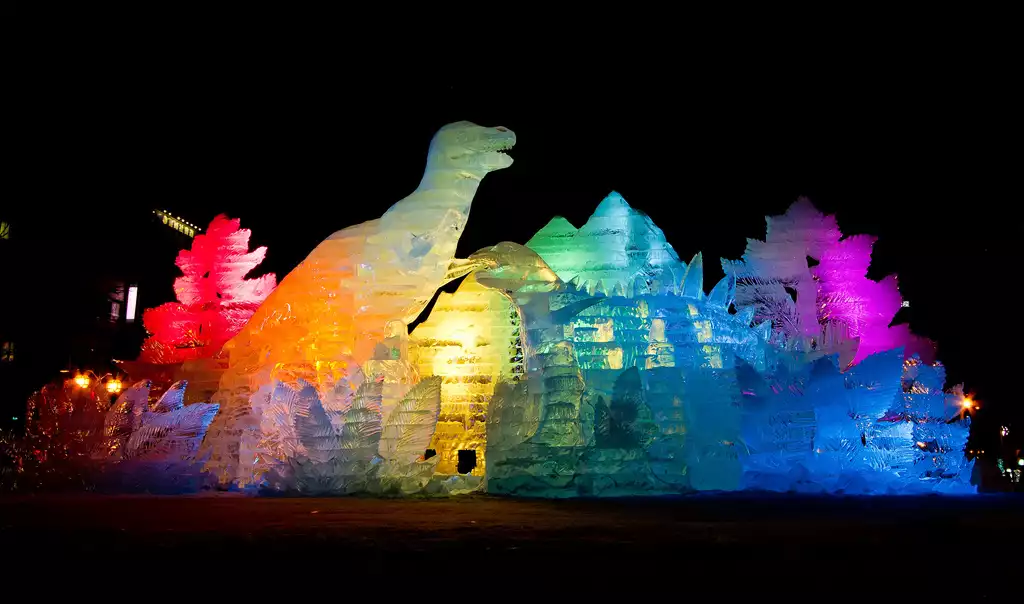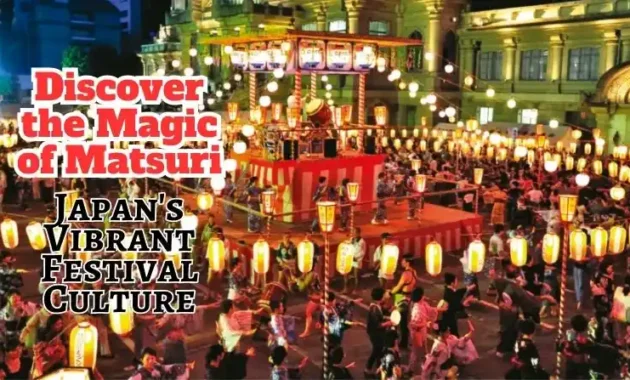Let me tell you about one of the most exciting and colorful celebrations in Japanese culture – Matsuri! Matsuri (祭) is a Japanese word that means “festival”, and it is a celebration of traditions, culture, and community.
Matsuri has a long history dating back to ancient times when people gathered to offer prayers for a good harvest and to give thanks to the gods for their blessings. Over time, Matsuri evolved to become a celebration of all aspects of Japanese culture and is now celebrated throughout the country with great enthusiasm.
Experiencing Matsuri firsthand is an unforgettable experience. It’s a chance to immerse yourself in the vibrant colors, sounds, and flavors of Japan’s rich culture. From the elaborate costumes and stunning decorations to the delicious street food and traditional music, Matsuri is bursting with energy and excitement.
So if you’re planning a trip to Japan, make sure to include Matsuri in your itinerary! It’s a fantastic way to learn more about the country’s history, traditions, and customs, and to connect with the local community.
Matsuri: A Celebration of Tradition and Culture
The various types of Matsuri
Now that you know about the basics of Matsuri, let’s dive deeper into what makes these festivals so special. Matsuri is a celebration of Japanese tradition and culture, and it comes in many different forms. Here are some of the most common types of Matsuri:
- Shrine Matsuri – These festivals are held at Shinto shrines and are usually associated with specific gods or deities. They often involve parades, processions, and traditional rituals.
- Street Matsuri – As the name suggests, these festivals take place on the streets and are characterized by lively music, colorful decorations, and delicious street food. They are often held during the summer months and are a great way to experience the local community.
- Fire Matsuri – These festivals involve the use of fire in some way, either through fireworks or torches. They are often held in the winter months and are believed to ward off evil spirits.
Significance of Matsuri costumes, food, and music
Matsuri is also known for its elaborate costumes, delicious food, and traditional music. Many Matsuri celebrations involve participants dressing up in colorful and ornate costumes that are specific to the festival’s theme. The food served during Matsuri is also a highlight, with street vendors selling everything from takoyaki (octopus balls) to yakisoba (fried noodles).
Music is also an essential part of Matsuri, with traditional instruments like taiko drums and shamisen guitars often featured. These instruments are used to create lively and upbeat rhythms that add to the festival’s energy and excitement.
Traditional Matsuri rituals and practices
Finally, Matsuri is known for its traditional rituals and practices. These vary depending on the festival, but they often involve offerings to the gods, purification ceremonies, and other religious observances. These rituals add a spiritual element to the festival and connect participants to Japan’s rich cultural heritage.
Matsuri is a celebration of Japanese tradition and culture that comes in many forms, each with its own unique characteristics. From costumes and food to music and rituals, there’s something for everyone to enjoy at Matsuri!
Matsuri: A Feast for the Senses
In this section, we’re going to talk about how Matsuri is truly a feast for the senses. From the vibrant colors and intricate designs of the decorations to the sounds of traditional Matsuri music and chants, and the taste of Matsuri street food and local delicacies, there’s something for everyone to enjoy.
The Vibrant Colors and Intricate Designs of Matsuri Decorations
One of the first things that will catch your eye when attending a Matsuri is the beautiful and ornate decorations. These can include everything from colorful lanterns and streamers to large, intricate floats. Each festival has its own unique decorations that reflect the theme of the event, and the level of detail and craftsmanship that goes into creating them is truly impressive.
The Sounds of Traditional Matsuri Music and Chants
Music is a significant part of Matsuri, and you’ll likely hear traditional instruments like taiko drums and shamisen guitars as you walk through the festival. The rhythms and beats of the music are upbeat and lively, creating a fun and energetic atmosphere. You may also hear chants and songs that are specific to the festival, adding to the overall cultural experience.
The Taste of Matsuri Street Food and Local Delicacies
Perhaps the most delicious aspect of Matsuri is the food! Matsuri street vendors offer a variety of mouth-watering treats, including yakisoba (fried noodles), takoyaki (octopus balls), and okonomiyaki (savory pancakes). Each region of Japan has its own local delicacies, so be sure to try some of the unique dishes that are specific to the festival you’re attending.
Matsuri is a true feast for the senses, offering a visual spectacle of colorful and intricate decorations, lively traditional music and chants, and a delicious array of street food and local delicacies. Be sure to come hungry and ready to immerse yourself in the sights and sounds of this vibrant festival culture!
Preparing for Matsuri: Tips and Tricks
Are you excited to attend your first Matsuri? Don’t worry; we’ve got you covered! In this section, we’ll provide you with some helpful tips and tricks to prepare for your Matsuri experience.
What to Wear to Matsuri
One of the most exciting aspects of Matsuri is getting dressed up in a traditional Japanese outfit, like a yukata or happi coat. But if you don’t have one, don’t worry; you can still dress comfortably and stylishly for the event.
Wear comfortable shoes, as you’ll likely be walking and standing for long periods, and dress for the weather since Matsuri takes place throughout the year. Keep in mind that modesty is a big part of Japanese culture, so avoid wearing revealing or offensive clothing.
How to Navigate Through Large Crowds During Matsuri
Matsuri is a popular event, and you’ll likely encounter large crowds of people. To avoid getting lost or separated from your group, set up a meeting spot in advance.
Use public transportation or walk to the festival location to avoid traffic jams and parking issues. Make sure to bring a small bag or purse to keep your belongings safe and easily accessible. Remember to be courteous to others, don’t push or shove, and enjoy the festive atmosphere!
Matsuri Etiquette and Customs to Keep in Mind
When attending a Matsuri, it’s essential to be aware of Japanese customs and etiquette. Bowing is a sign of respect in Japan, and it’s customary to bow when greeting someone. Be mindful of your actions and language, as cultural differences may cause misunderstandings.
When eating street food, it’s polite to eat while standing or sitting at designated eating areas. Lastly, be respectful when taking photos and ask for permission before taking pictures of people or their belongings.
These tips and tricks will help you make the most out of your Matsuri experience. Remember to dress comfortably, plan ahead, and be respectful of Japanese customs and etiquette. With these tips in mind, you’ll be able to fully immerse yourself in the vibrant and exciting world of Matsuri!
Top Matsuri Festivals in Japan
If you’re planning a trip to Japan, attending a Matsuri festival should be at the top of your list. Here are some of the most popular and unique Matsuri festivals in Japan that you don’t want to miss:
1. Gion Matsuri
Gion Matsuri is one of the most famous and largest festivals in Japan, held annually in Kyoto during the month of July. It is a celebration of the city’s patron deity, Yasaka Shrine, and involves a parade of elaborate floats known as yamaboko.

The festival dates back to the 9th century and has evolved over the years to include various events such as traditional dance performances, street food stalls, and a lively street party atmosphere.
Gion Matsuri is a symbol of Kyoto’s rich history and cultural heritage and attracts thousands of visitors from around the world each year.
2. Awa Odori
Awa Odori is a traditional dance festival held annually in Tokushima, Japan. It takes place during Obon season in mid-August and attracts over a million visitors each year. The festival features groups of dancers known as “ren” who perform the Awa Odori dance, which has a lively and energetic style characterized by synchronized movements and colorful costumes.

The festival has its roots in the Bon Odori, a traditional dance performed to welcome the spirits of ancestors during the Obon season. Awa Odori is believed to have originated in the 16th century and has since become a major cultural event in Japan, promoting community spirit and traditional Japanese culture.
3. Kanda Matsuri
Kanda Matsuri is a biennial festival held in Tokyo, Japan in mid-May. It is considered one of the three great festivals of Tokyo, alongside the Sanno Matsuri and the Fukagawa Matsuri. The festival originated in the Edo period, when the shogunate ordered the Kanda Myojin Shrine to hold a festival to celebrate the completion of a new main hall.

During the festival, a large parade featuring mikoshi (portable shrines) is held through the streets of central Tokyo. The parade includes musicians, dancers, and participants wearing traditional clothing. The mikoshi, which are carried by groups of people, are said to represent the shrine’s deities and are believed to bring good luck and ward off evil spirits.
In addition to the parade, there are also various ceremonies and rituals held at the Kanda Myojin Shrine, including purification rituals and prayers for good fortune. The festival attracts thousands of visitors from around Japan and the world and is known for its lively atmosphere and colorful displays.
4. Nebuta Matsuri
Nebuta Matsuri is a popular summer festival held in Aomori, a prefecture located in the northern region of Japan. The festival is held annually from August 2 to 7 and attracts millions of visitors from around the world.

The highlight of the festival is the procession of enormous, illuminated paper lantern floats known as “nebuta” which are paraded through the streets by dancers, musicians, and performers. The floats are often based on famous historical or mythical figures, and are accompanied by traditional music and dance performances.
Nebuta Matsuri also features a variety of other cultural events and activities, such as fireworks displays, traditional Japanese theater performances, and local food and craft vendors. The festival is a celebration of the region’s unique culture and history, and is a must-see event for anyone interested in experiencing the vibrant and colorful traditions of Japan.
5. Tanabata Matsuri
Tanabata Matsuri, also known as the Star Festival, is a Japanese festival that celebrates the meeting of two deities, Orihime and Hikoboshi, who are represented by the stars Vega and Altair. The festival is held on July 7th, or sometimes in early August, and is celebrated throughout Japan, but is particularly famous in the city of Sendai.

During the festival, colorful paper decorations, including bamboo branches decorated with strips of paper, are hung outside homes and businesses. People write wishes on small pieces of paper called tanzaku and hang them on the bamboo branches.
The festival also includes traditional Japanese dances and music performances. In some regions, people wear yukata, a type of lightweight kimono, to participate in the festivities.
The origins of Tanabata Matsuri date back over 1,000 years and have evolved over time to include various customs and traditions. It is a beloved festival that celebrates love and the power of wishes and is enjoyed by people of all ages.
6. Sapporo Snow Festival
The Sapporo Snow Festival, also known as the Sapporo Yuki Matsuri, is an annual winter festival held in Sapporo, the capital city of Hokkaido, Japan. The festival takes place over a week in early February and attracts millions of visitors from all over the world.

The highlight of the festival is the snow and ice sculptures, some of which are over 15 meters tall and beautifully lit up at night. These sculptures are created by local and international artists, and are spread out across three sites: the main site at Odori Park, the Susukino site, and the Tsudome site.
In addition to the sculptures, there are also various events and activities taking place throughout the festival, such as food stalls offering local Hokkaido cuisine, concerts, ice skating, and snowboarding competitions. The festival has been held annually since 1950, and has grown in popularity and size over the years, making it one of the most popular winter festivals in Japan.
Tips for attending each festival
Attending a Matsuri festival can be overwhelming, but with some preparation and planning, you can fully enjoy the experience. Here are some tips for attending Matsuri festivals:
- Dress appropriately: Wear comfortable shoes and light clothing that you can move around in. Some Matsuri festivals take place in the summer months, so make sure to bring sunscreen and a hat.
- Plan ahead: Research the festival beforehand and plan which events and activities you want to attend. Matsuri festivals can get crowded, so arrive early to secure a good viewing spot.
- Respect local customs: Matsuri festivals are an important part of Japanese culture, so make sure to respect local customs and etiquette. Don’t litter, don’t take pictures or videos where it’s not allowed, and be mindful of personal space in crowded areas.
By following these tips and attending one of Japan’s top Matsuri festivals, you’ll be sure to have a once-in-a-lifetime experience and gain a deeper appreciation for Japanese culture and traditions.
The Future of Matsuri: Modern Adaptations and Innovations
Matsuri has been an integral part of Japanese culture for centuries. While the traditional customs and practices associated with Matsuri have been preserved over the years, Matsuri festivals have also undergone significant changes to keep up with the times. In this section, we’ll explore the modern adaptations and innovations of Matsuri and how they have impacted this vibrant festival culture.
Matsuri Evolution Over the Years
Matsuri has come a long way since its inception. From being a religious ritual to celebrate the gods and ward off evil spirits, Matsuri has now become a celebration of Japanese culture and heritage. Over time, Matsuri festivals have expanded in size and scale, attracting tourists from all over the world.
Fusion of Traditional and Modern Elements
One of the most notable developments in Matsuri festivals is the fusion of traditional Matsuri elements with modern technology and entertainment. Some Matsuri events feature modern music performances and light shows alongside traditional rituals and ceremonies. This fusion has made Matsuri festivals more exciting and appealing to younger generations.
Role in Promoting Tourism and Cultural Exchange
Matsuri festivals play a crucial role in promoting tourism and cultural exchange. They provide an opportunity for visitors to experience Japanese culture firsthand and learn about the country’s rich heritage. Matsuri festivals are also a platform for cultural exchange, as performers and participants from different regions and countries showcase their traditions and customs.
Matsuri festivals have come a long way since their inception, and they continue to evolve with the times. The fusion of traditional and modern elements and the role of Matsuri in promoting tourism and cultural exchange have ensured that this vibrant festival culture remains relevant and exciting for generations to come.
Conclusion
Matsuri is an integral part of Japanese culture, and its significance cannot be overstated. The festive atmosphere, traditional rituals, and mouth-watering food make Matsuri a truly unique and unforgettable experience. It’s a celebration of community and tradition, and attending a Matsuri festival is a great way to immerse yourself in Japanese culture.
We hope this guide has given you a good understanding of Matsuri and its various aspects. Whether you’re a first-time visitor or a seasoned Matsuri-goer, there’s always something new to discover and enjoy.
So why not plan a trip to Japan and experience Matsuri for yourself? It’s an opportunity to see Japan at its most vibrant and colorful, and a chance to connect with the locals and experience their warm hospitality. Don’t forget to take lots of photos and memories to cherish for a lifetime.


